Evidence-Based Practices in Breast Cancer: Principles, Patient Preferences, and Implementation
VerifiedAdded on 2023/06/09
|17
|3326
|392
AI Summary
This article discusses evidence-based practices in breast cancer, including principles and processes, the importance of individual patient preferences, and barriers and facilitators to implementation. It also includes a literature review of breast cancer and pregnancy.
Contribute Materials
Your contribution can guide someone’s learning journey. Share your
documents today.
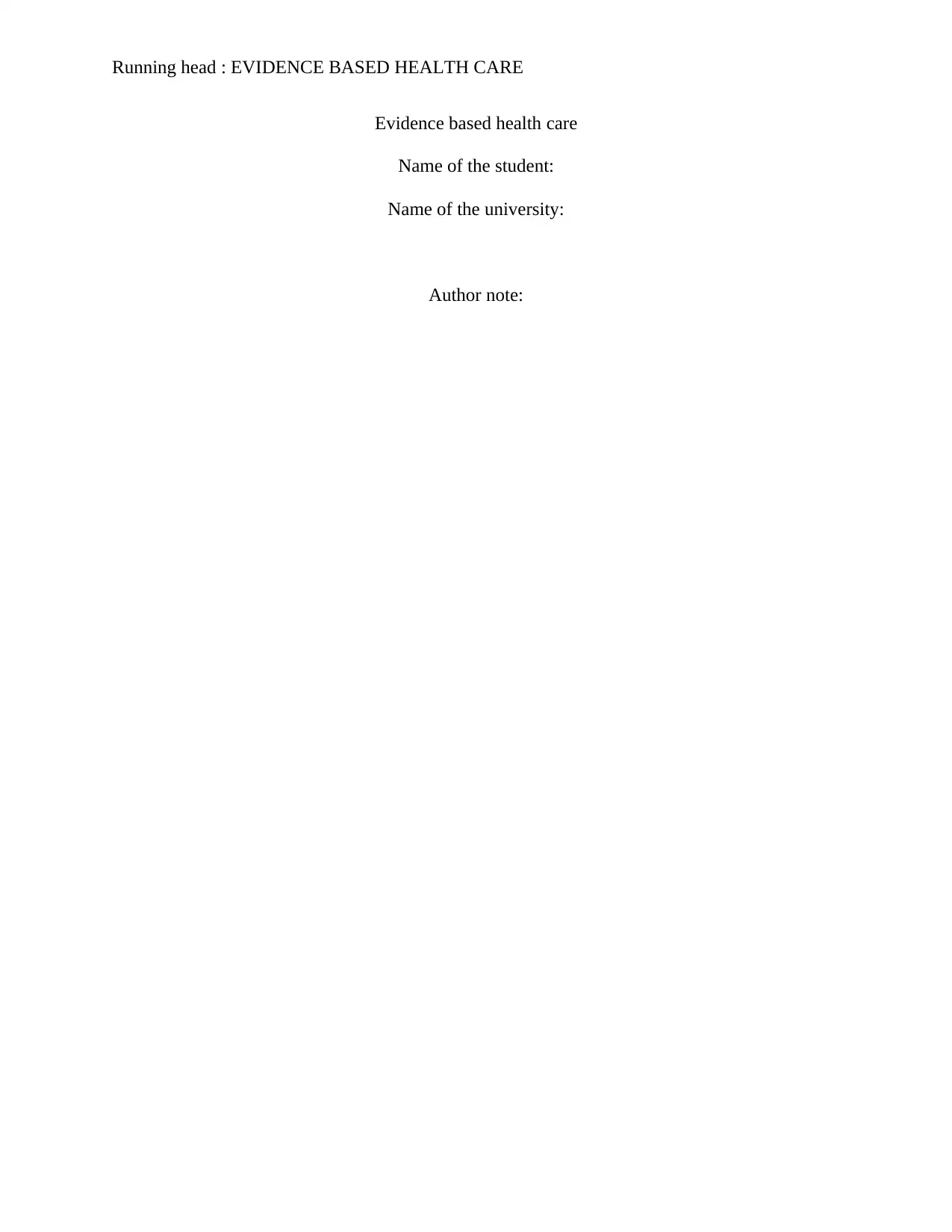
Running head : EVIDENCE BASED HEALTH CARE
Evidence based health care
Name of the student:
Name of the university:
Author note:
Evidence based health care
Name of the student:
Name of the university:
Author note:
Secure Best Marks with AI Grader
Need help grading? Try our AI Grader for instant feedback on your assignments.
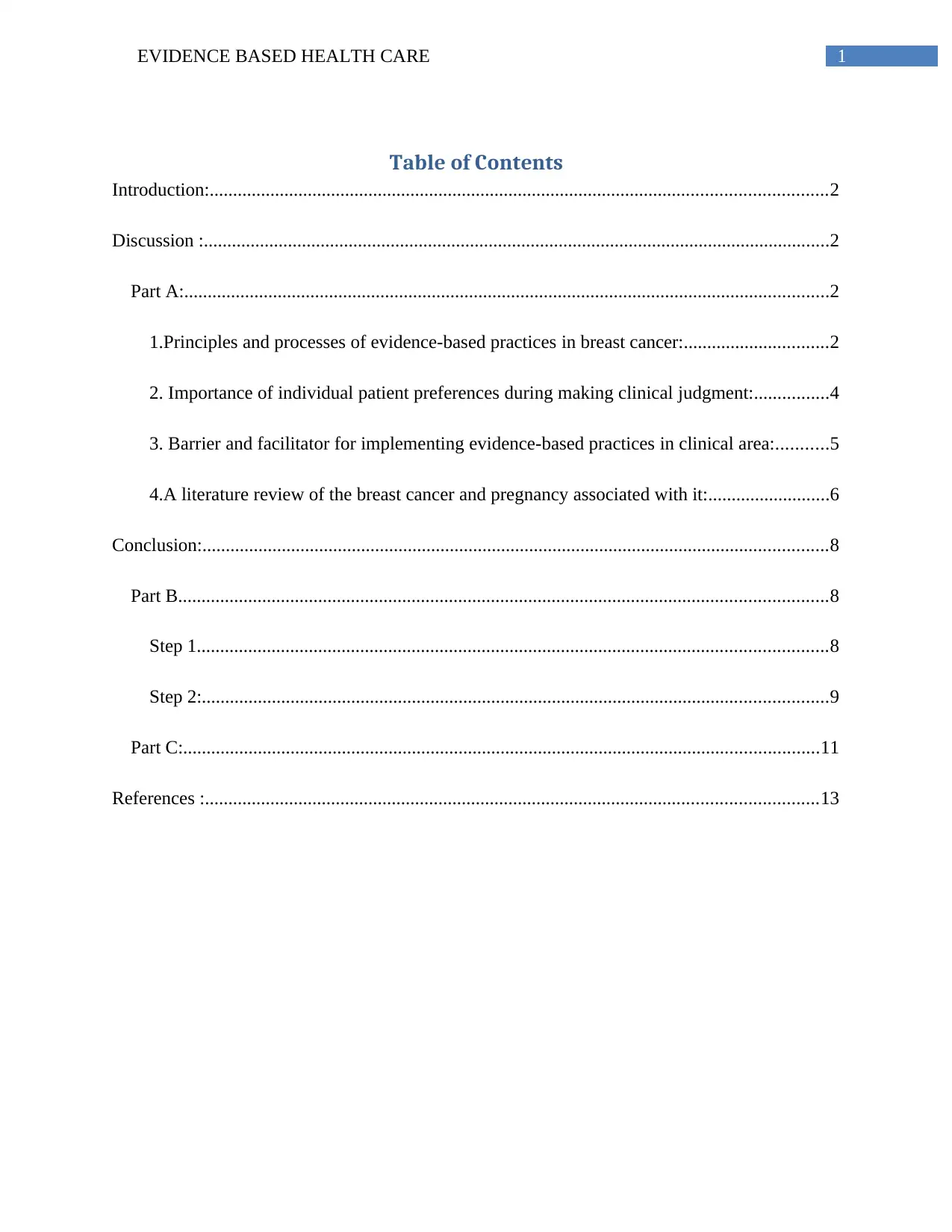
1EVIDENCE BASED HEALTH CARE
Table of Contents
Introduction:....................................................................................................................................2
Discussion :......................................................................................................................................2
Part A:..........................................................................................................................................2
1.Principles and processes of evidence-based practices in breast cancer:...............................2
2. Importance of individual patient preferences during making clinical judgment:................4
3. Barrier and facilitator for implementing evidence-based practices in clinical area:...........5
4.A literature review of the breast cancer and pregnancy associated with it:..........................6
Conclusion:......................................................................................................................................8
Part B...........................................................................................................................................8
Step 1.......................................................................................................................................8
Step 2:......................................................................................................................................9
Part C:........................................................................................................................................11
References :...................................................................................................................................13
Table of Contents
Introduction:....................................................................................................................................2
Discussion :......................................................................................................................................2
Part A:..........................................................................................................................................2
1.Principles and processes of evidence-based practices in breast cancer:...............................2
2. Importance of individual patient preferences during making clinical judgment:................4
3. Barrier and facilitator for implementing evidence-based practices in clinical area:...........5
4.A literature review of the breast cancer and pregnancy associated with it:..........................6
Conclusion:......................................................................................................................................8
Part B...........................................................................................................................................8
Step 1.......................................................................................................................................8
Step 2:......................................................................................................................................9
Part C:........................................................................................................................................11
References :...................................................................................................................................13
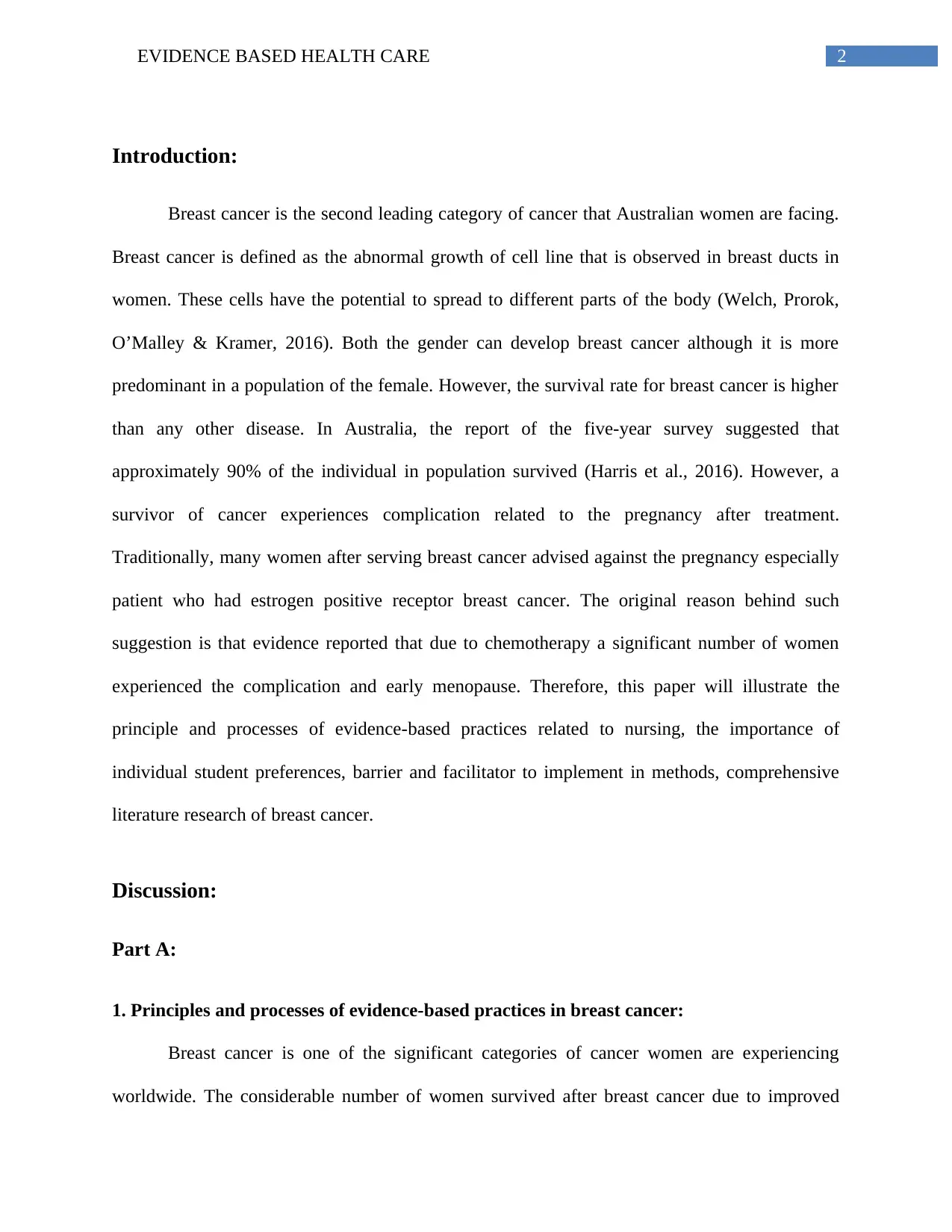
2EVIDENCE BASED HEALTH CARE
Introduction:
Breast cancer is the second leading category of cancer that Australian women are facing.
Breast cancer is defined as the abnormal growth of cell line that is observed in breast ducts in
women. These cells have the potential to spread to different parts of the body (Welch, Prorok,
O’Malley & Kramer, 2016). Both the gender can develop breast cancer although it is more
predominant in a population of the female. However, the survival rate for breast cancer is higher
than any other disease. In Australia, the report of the five-year survey suggested that
approximately 90% of the individual in population survived (Harris et al., 2016). However, a
survivor of cancer experiences complication related to the pregnancy after treatment.
Traditionally, many women after serving breast cancer advised against the pregnancy especially
patient who had estrogen positive receptor breast cancer. The original reason behind such
suggestion is that evidence reported that due to chemotherapy a significant number of women
experienced the complication and early menopause. Therefore, this paper will illustrate the
principle and processes of evidence-based practices related to nursing, the importance of
individual student preferences, barrier and facilitator to implement in methods, comprehensive
literature research of breast cancer.
Discussion:
Part A:
1. Principles and processes of evidence-based practices in breast cancer:
Breast cancer is one of the significant categories of cancer women are experiencing
worldwide. The considerable number of women survived after breast cancer due to improved
Introduction:
Breast cancer is the second leading category of cancer that Australian women are facing.
Breast cancer is defined as the abnormal growth of cell line that is observed in breast ducts in
women. These cells have the potential to spread to different parts of the body (Welch, Prorok,
O’Malley & Kramer, 2016). Both the gender can develop breast cancer although it is more
predominant in a population of the female. However, the survival rate for breast cancer is higher
than any other disease. In Australia, the report of the five-year survey suggested that
approximately 90% of the individual in population survived (Harris et al., 2016). However, a
survivor of cancer experiences complication related to the pregnancy after treatment.
Traditionally, many women after serving breast cancer advised against the pregnancy especially
patient who had estrogen positive receptor breast cancer. The original reason behind such
suggestion is that evidence reported that due to chemotherapy a significant number of women
experienced the complication and early menopause. Therefore, this paper will illustrate the
principle and processes of evidence-based practices related to nursing, the importance of
individual student preferences, barrier and facilitator to implement in methods, comprehensive
literature research of breast cancer.
Discussion:
Part A:
1. Principles and processes of evidence-based practices in breast cancer:
Breast cancer is one of the significant categories of cancer women are experiencing
worldwide. The considerable number of women survived after breast cancer due to improved
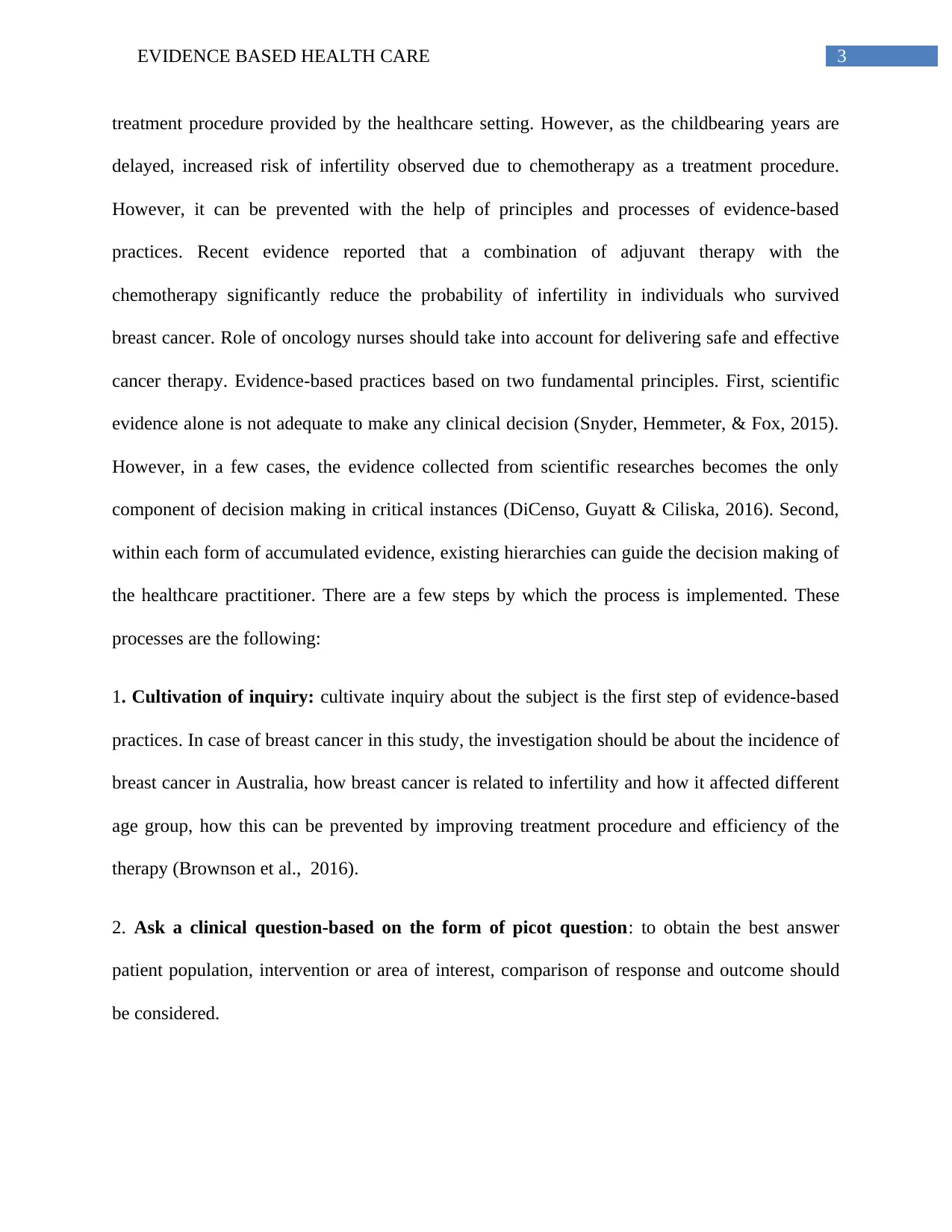
3EVIDENCE BASED HEALTH CARE
treatment procedure provided by the healthcare setting. However, as the childbearing years are
delayed, increased risk of infertility observed due to chemotherapy as a treatment procedure.
However, it can be prevented with the help of principles and processes of evidence-based
practices. Recent evidence reported that a combination of adjuvant therapy with the
chemotherapy significantly reduce the probability of infertility in individuals who survived
breast cancer. Role of oncology nurses should take into account for delivering safe and effective
cancer therapy. Evidence-based practices based on two fundamental principles. First, scientific
evidence alone is not adequate to make any clinical decision (Snyder, Hemmeter, & Fox, 2015).
However, in a few cases, the evidence collected from scientific researches becomes the only
component of decision making in critical instances (DiCenso, Guyatt & Ciliska, 2016). Second,
within each form of accumulated evidence, existing hierarchies can guide the decision making of
the healthcare practitioner. There are a few steps by which the process is implemented. These
processes are the following:
1. Cultivation of inquiry: cultivate inquiry about the subject is the first step of evidence-based
practices. In case of breast cancer in this study, the investigation should be about the incidence of
breast cancer in Australia, how breast cancer is related to infertility and how it affected different
age group, how this can be prevented by improving treatment procedure and efficiency of the
therapy (Brownson et al., 2016).
2. Ask a clinical question-based on the form of picot question: to obtain the best answer
patient population, intervention or area of interest, comparison of response and outcome should
be considered.
treatment procedure provided by the healthcare setting. However, as the childbearing years are
delayed, increased risk of infertility observed due to chemotherapy as a treatment procedure.
However, it can be prevented with the help of principles and processes of evidence-based
practices. Recent evidence reported that a combination of adjuvant therapy with the
chemotherapy significantly reduce the probability of infertility in individuals who survived
breast cancer. Role of oncology nurses should take into account for delivering safe and effective
cancer therapy. Evidence-based practices based on two fundamental principles. First, scientific
evidence alone is not adequate to make any clinical decision (Snyder, Hemmeter, & Fox, 2015).
However, in a few cases, the evidence collected from scientific researches becomes the only
component of decision making in critical instances (DiCenso, Guyatt & Ciliska, 2016). Second,
within each form of accumulated evidence, existing hierarchies can guide the decision making of
the healthcare practitioner. There are a few steps by which the process is implemented. These
processes are the following:
1. Cultivation of inquiry: cultivate inquiry about the subject is the first step of evidence-based
practices. In case of breast cancer in this study, the investigation should be about the incidence of
breast cancer in Australia, how breast cancer is related to infertility and how it affected different
age group, how this can be prevented by improving treatment procedure and efficiency of the
therapy (Brownson et al., 2016).
2. Ask a clinical question-based on the form of picot question: to obtain the best answer
patient population, intervention or area of interest, comparison of response and outcome should
be considered.
Secure Best Marks with AI Grader
Need help grading? Try our AI Grader for instant feedback on your assignments.
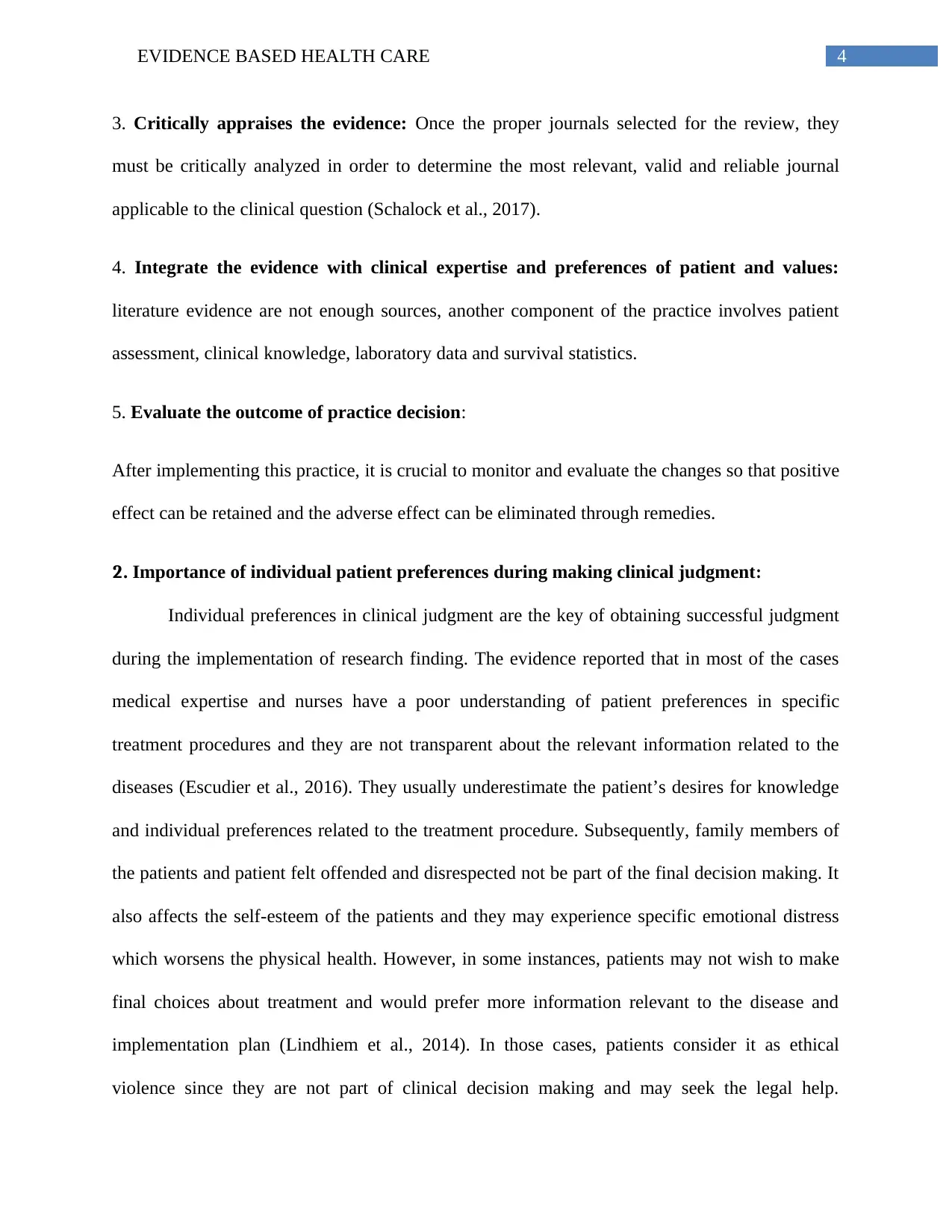
4EVIDENCE BASED HEALTH CARE
3. Critically appraises the evidence: Once the proper journals selected for the review, they
must be critically analyzed in order to determine the most relevant, valid and reliable journal
applicable to the clinical question (Schalock et al., 2017).
4. Integrate the evidence with clinical expertise and preferences of patient and values:
literature evidence are not enough sources, another component of the practice involves patient
assessment, clinical knowledge, laboratory data and survival statistics.
5. Evaluate the outcome of practice decision:
After implementing this practice, it is crucial to monitor and evaluate the changes so that positive
effect can be retained and the adverse effect can be eliminated through remedies.
2. Importance of individual patient preferences during making clinical judgment:
Individual preferences in clinical judgment are the key of obtaining successful judgment
during the implementation of research finding. The evidence reported that in most of the cases
medical expertise and nurses have a poor understanding of patient preferences in specific
treatment procedures and they are not transparent about the relevant information related to the
diseases (Escudier et al., 2016). They usually underestimate the patient’s desires for knowledge
and individual preferences related to the treatment procedure. Subsequently, family members of
the patients and patient felt offended and disrespected not be part of the final decision making. It
also affects the self-esteem of the patients and they may experience specific emotional distress
which worsens the physical health. However, in some instances, patients may not wish to make
final choices about treatment and would prefer more information relevant to the disease and
implementation plan (Lindhiem et al., 2014). In those cases, patients consider it as ethical
violence since they are not part of clinical decision making and may seek the legal help.
3. Critically appraises the evidence: Once the proper journals selected for the review, they
must be critically analyzed in order to determine the most relevant, valid and reliable journal
applicable to the clinical question (Schalock et al., 2017).
4. Integrate the evidence with clinical expertise and preferences of patient and values:
literature evidence are not enough sources, another component of the practice involves patient
assessment, clinical knowledge, laboratory data and survival statistics.
5. Evaluate the outcome of practice decision:
After implementing this practice, it is crucial to monitor and evaluate the changes so that positive
effect can be retained and the adverse effect can be eliminated through remedies.
2. Importance of individual patient preferences during making clinical judgment:
Individual preferences in clinical judgment are the key of obtaining successful judgment
during the implementation of research finding. The evidence reported that in most of the cases
medical expertise and nurses have a poor understanding of patient preferences in specific
treatment procedures and they are not transparent about the relevant information related to the
diseases (Escudier et al., 2016). They usually underestimate the patient’s desires for knowledge
and individual preferences related to the treatment procedure. Subsequently, family members of
the patients and patient felt offended and disrespected not be part of the final decision making. It
also affects the self-esteem of the patients and they may experience specific emotional distress
which worsens the physical health. However, in some instances, patients may not wish to make
final choices about treatment and would prefer more information relevant to the disease and
implementation plan (Lindhiem et al., 2014). In those cases, patients consider it as ethical
violence since they are not part of clinical decision making and may seek the legal help.
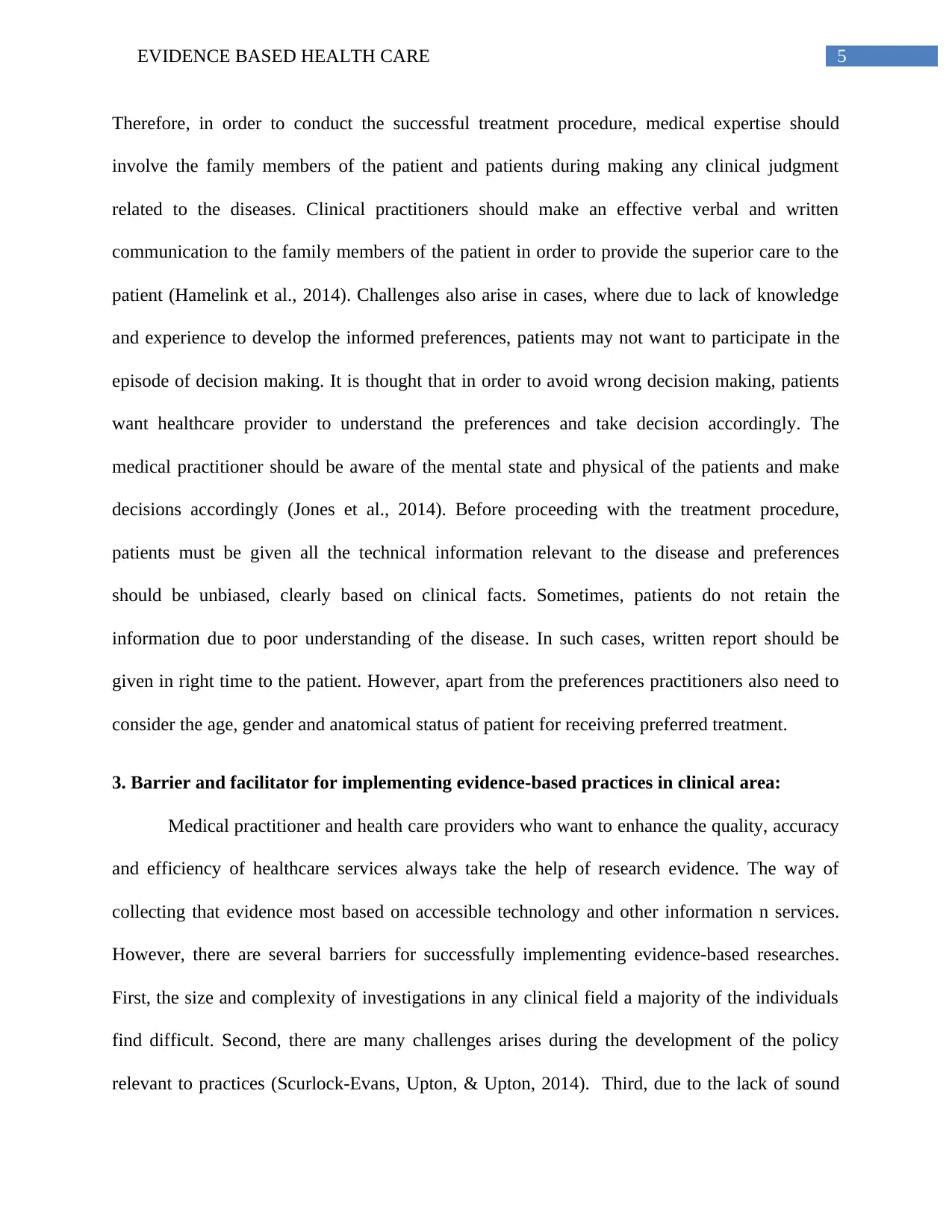
5EVIDENCE BASED HEALTH CARE
Therefore, in order to conduct the successful treatment procedure, medical expertise should
involve the family members of the patient and patients during making any clinical judgment
related to the diseases. Clinical practitioners should make an effective verbal and written
communication to the family members of the patient in order to provide the superior care to the
patient (Hamelink et al., 2014). Challenges also arise in cases, where due to lack of knowledge
and experience to develop the informed preferences, patients may not want to participate in the
episode of decision making. It is thought that in order to avoid wrong decision making, patients
want healthcare provider to understand the preferences and take decision accordingly. The
medical practitioner should be aware of the mental state and physical of the patients and make
decisions accordingly (Jones et al., 2014). Before proceeding with the treatment procedure,
patients must be given all the technical information relevant to the disease and preferences
should be unbiased, clearly based on clinical facts. Sometimes, patients do not retain the
information due to poor understanding of the disease. In such cases, written report should be
given in right time to the patient. However, apart from the preferences practitioners also need to
consider the age, gender and anatomical status of patient for receiving preferred treatment.
3. Barrier and facilitator for implementing evidence-based practices in clinical area:
Medical practitioner and health care providers who want to enhance the quality, accuracy
and efficiency of healthcare services always take the help of research evidence. The way of
collecting that evidence most based on accessible technology and other information n services.
However, there are several barriers for successfully implementing evidence-based researches.
First, the size and complexity of investigations in any clinical field a majority of the individuals
find difficult. Second, there are many challenges arises during the development of the policy
relevant to practices (Scurlock-Evans, Upton, & Upton, 2014). Third, due to the lack of sound
Therefore, in order to conduct the successful treatment procedure, medical expertise should
involve the family members of the patient and patients during making any clinical judgment
related to the diseases. Clinical practitioners should make an effective verbal and written
communication to the family members of the patient in order to provide the superior care to the
patient (Hamelink et al., 2014). Challenges also arise in cases, where due to lack of knowledge
and experience to develop the informed preferences, patients may not want to participate in the
episode of decision making. It is thought that in order to avoid wrong decision making, patients
want healthcare provider to understand the preferences and take decision accordingly. The
medical practitioner should be aware of the mental state and physical of the patients and make
decisions accordingly (Jones et al., 2014). Before proceeding with the treatment procedure,
patients must be given all the technical information relevant to the disease and preferences
should be unbiased, clearly based on clinical facts. Sometimes, patients do not retain the
information due to poor understanding of the disease. In such cases, written report should be
given in right time to the patient. However, apart from the preferences practitioners also need to
consider the age, gender and anatomical status of patient for receiving preferred treatment.
3. Barrier and facilitator for implementing evidence-based practices in clinical area:
Medical practitioner and health care providers who want to enhance the quality, accuracy
and efficiency of healthcare services always take the help of research evidence. The way of
collecting that evidence most based on accessible technology and other information n services.
However, there are several barriers for successfully implementing evidence-based researches.
First, the size and complexity of investigations in any clinical field a majority of the individuals
find difficult. Second, there are many challenges arises during the development of the policy
relevant to practices (Scurlock-Evans, Upton, & Upton, 2014). Third, due to the lack of sound
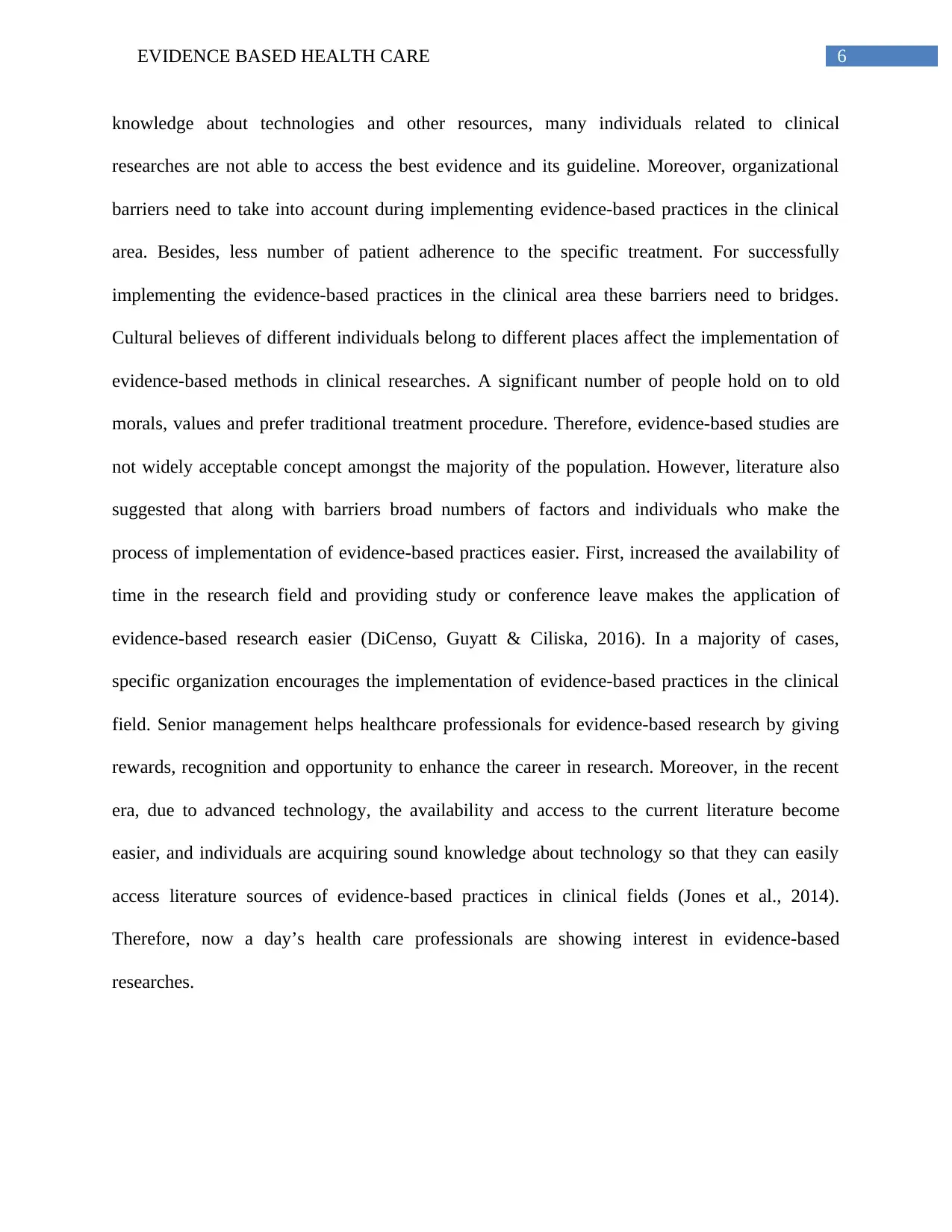
6EVIDENCE BASED HEALTH CARE
knowledge about technologies and other resources, many individuals related to clinical
researches are not able to access the best evidence and its guideline. Moreover, organizational
barriers need to take into account during implementing evidence-based practices in the clinical
area. Besides, less number of patient adherence to the specific treatment. For successfully
implementing the evidence-based practices in the clinical area these barriers need to bridges.
Cultural believes of different individuals belong to different places affect the implementation of
evidence-based methods in clinical researches. A significant number of people hold on to old
morals, values and prefer traditional treatment procedure. Therefore, evidence-based studies are
not widely acceptable concept amongst the majority of the population. However, literature also
suggested that along with barriers broad numbers of factors and individuals who make the
process of implementation of evidence-based practices easier. First, increased the availability of
time in the research field and providing study or conference leave makes the application of
evidence-based research easier (DiCenso, Guyatt & Ciliska, 2016). In a majority of cases,
specific organization encourages the implementation of evidence-based practices in the clinical
field. Senior management helps healthcare professionals for evidence-based research by giving
rewards, recognition and opportunity to enhance the career in research. Moreover, in the recent
era, due to advanced technology, the availability and access to the current literature become
easier, and individuals are acquiring sound knowledge about technology so that they can easily
access literature sources of evidence-based practices in clinical fields (Jones et al., 2014).
Therefore, now a day’s health care professionals are showing interest in evidence-based
researches.
knowledge about technologies and other resources, many individuals related to clinical
researches are not able to access the best evidence and its guideline. Moreover, organizational
barriers need to take into account during implementing evidence-based practices in the clinical
area. Besides, less number of patient adherence to the specific treatment. For successfully
implementing the evidence-based practices in the clinical area these barriers need to bridges.
Cultural believes of different individuals belong to different places affect the implementation of
evidence-based methods in clinical researches. A significant number of people hold on to old
morals, values and prefer traditional treatment procedure. Therefore, evidence-based studies are
not widely acceptable concept amongst the majority of the population. However, literature also
suggested that along with barriers broad numbers of factors and individuals who make the
process of implementation of evidence-based practices easier. First, increased the availability of
time in the research field and providing study or conference leave makes the application of
evidence-based research easier (DiCenso, Guyatt & Ciliska, 2016). In a majority of cases,
specific organization encourages the implementation of evidence-based practices in the clinical
field. Senior management helps healthcare professionals for evidence-based research by giving
rewards, recognition and opportunity to enhance the career in research. Moreover, in the recent
era, due to advanced technology, the availability and access to the current literature become
easier, and individuals are acquiring sound knowledge about technology so that they can easily
access literature sources of evidence-based practices in clinical fields (Jones et al., 2014).
Therefore, now a day’s health care professionals are showing interest in evidence-based
researches.
Paraphrase This Document
Need a fresh take? Get an instant paraphrase of this document with our AI Paraphraser
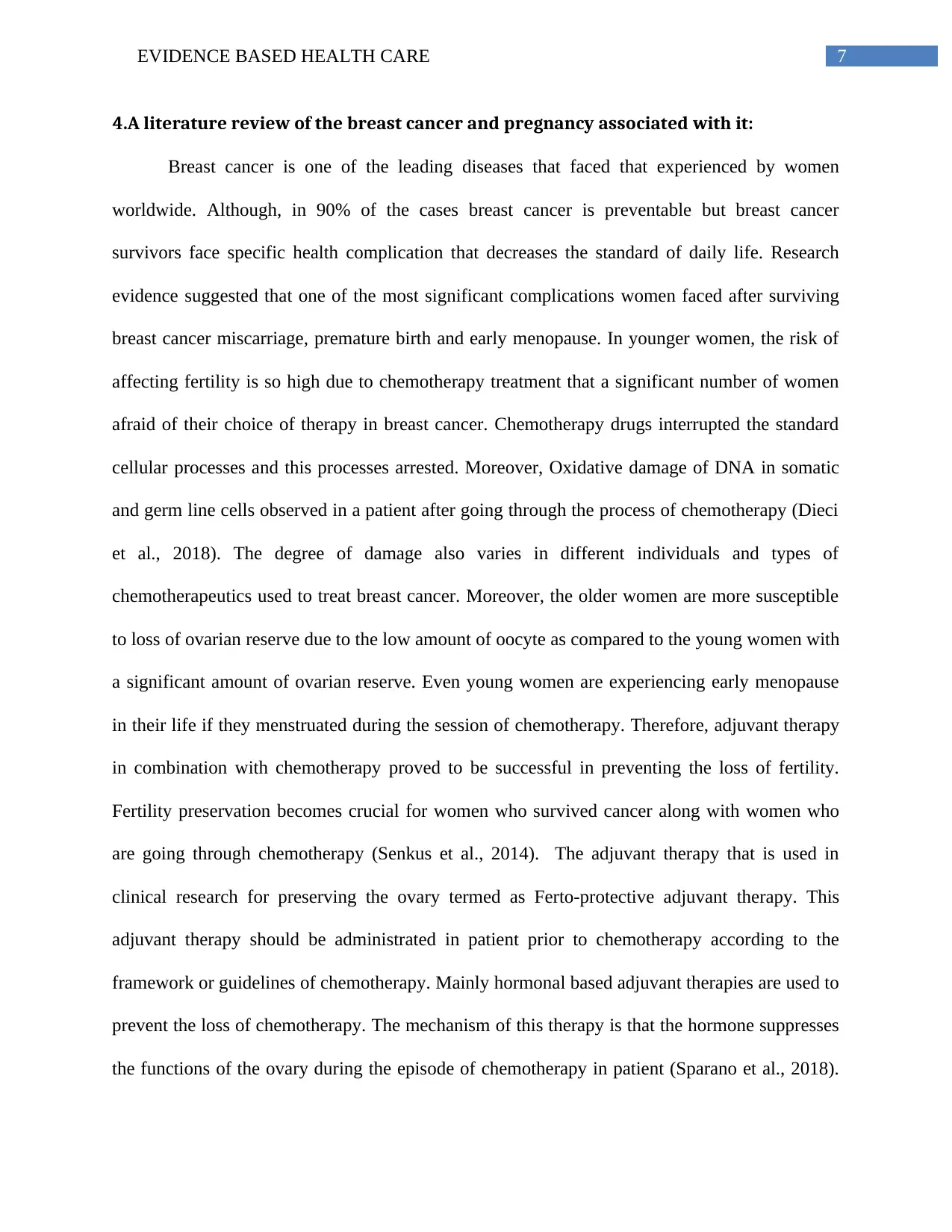
7EVIDENCE BASED HEALTH CARE
4.A literature review of the breast cancer and pregnancy associated with it:
Breast cancer is one of the leading diseases that faced that experienced by women
worldwide. Although, in 90% of the cases breast cancer is preventable but breast cancer
survivors face specific health complication that decreases the standard of daily life. Research
evidence suggested that one of the most significant complications women faced after surviving
breast cancer miscarriage, premature birth and early menopause. In younger women, the risk of
affecting fertility is so high due to chemotherapy treatment that a significant number of women
afraid of their choice of therapy in breast cancer. Chemotherapy drugs interrupted the standard
cellular processes and this processes arrested. Moreover, Oxidative damage of DNA in somatic
and germ line cells observed in a patient after going through the process of chemotherapy (Dieci
et al., 2018). The degree of damage also varies in different individuals and types of
chemotherapeutics used to treat breast cancer. Moreover, the older women are more susceptible
to loss of ovarian reserve due to the low amount of oocyte as compared to the young women with
a significant amount of ovarian reserve. Even young women are experiencing early menopause
in their life if they menstruated during the session of chemotherapy. Therefore, adjuvant therapy
in combination with chemotherapy proved to be successful in preventing the loss of fertility.
Fertility preservation becomes crucial for women who survived cancer along with women who
are going through chemotherapy (Senkus et al., 2014). The adjuvant therapy that is used in
clinical research for preserving the ovary termed as Ferto-protective adjuvant therapy. This
adjuvant therapy should be administrated in patient prior to chemotherapy according to the
framework or guidelines of chemotherapy. Mainly hormonal based adjuvant therapies are used to
prevent the loss of chemotherapy. The mechanism of this therapy is that the hormone suppresses
the functions of the ovary during the episode of chemotherapy in patient (Sparano et al., 2018).
4.A literature review of the breast cancer and pregnancy associated with it:
Breast cancer is one of the leading diseases that faced that experienced by women
worldwide. Although, in 90% of the cases breast cancer is preventable but breast cancer
survivors face specific health complication that decreases the standard of daily life. Research
evidence suggested that one of the most significant complications women faced after surviving
breast cancer miscarriage, premature birth and early menopause. In younger women, the risk of
affecting fertility is so high due to chemotherapy treatment that a significant number of women
afraid of their choice of therapy in breast cancer. Chemotherapy drugs interrupted the standard
cellular processes and this processes arrested. Moreover, Oxidative damage of DNA in somatic
and germ line cells observed in a patient after going through the process of chemotherapy (Dieci
et al., 2018). The degree of damage also varies in different individuals and types of
chemotherapeutics used to treat breast cancer. Moreover, the older women are more susceptible
to loss of ovarian reserve due to the low amount of oocyte as compared to the young women with
a significant amount of ovarian reserve. Even young women are experiencing early menopause
in their life if they menstruated during the session of chemotherapy. Therefore, adjuvant therapy
in combination with chemotherapy proved to be successful in preventing the loss of fertility.
Fertility preservation becomes crucial for women who survived cancer along with women who
are going through chemotherapy (Senkus et al., 2014). The adjuvant therapy that is used in
clinical research for preserving the ovary termed as Ferto-protective adjuvant therapy. This
adjuvant therapy should be administrated in patient prior to chemotherapy according to the
framework or guidelines of chemotherapy. Mainly hormonal based adjuvant therapies are used to
prevent the loss of chemotherapy. The mechanism of this therapy is that the hormone suppresses
the functions of the ovary during the episode of chemotherapy in patient (Sparano et al., 2018).
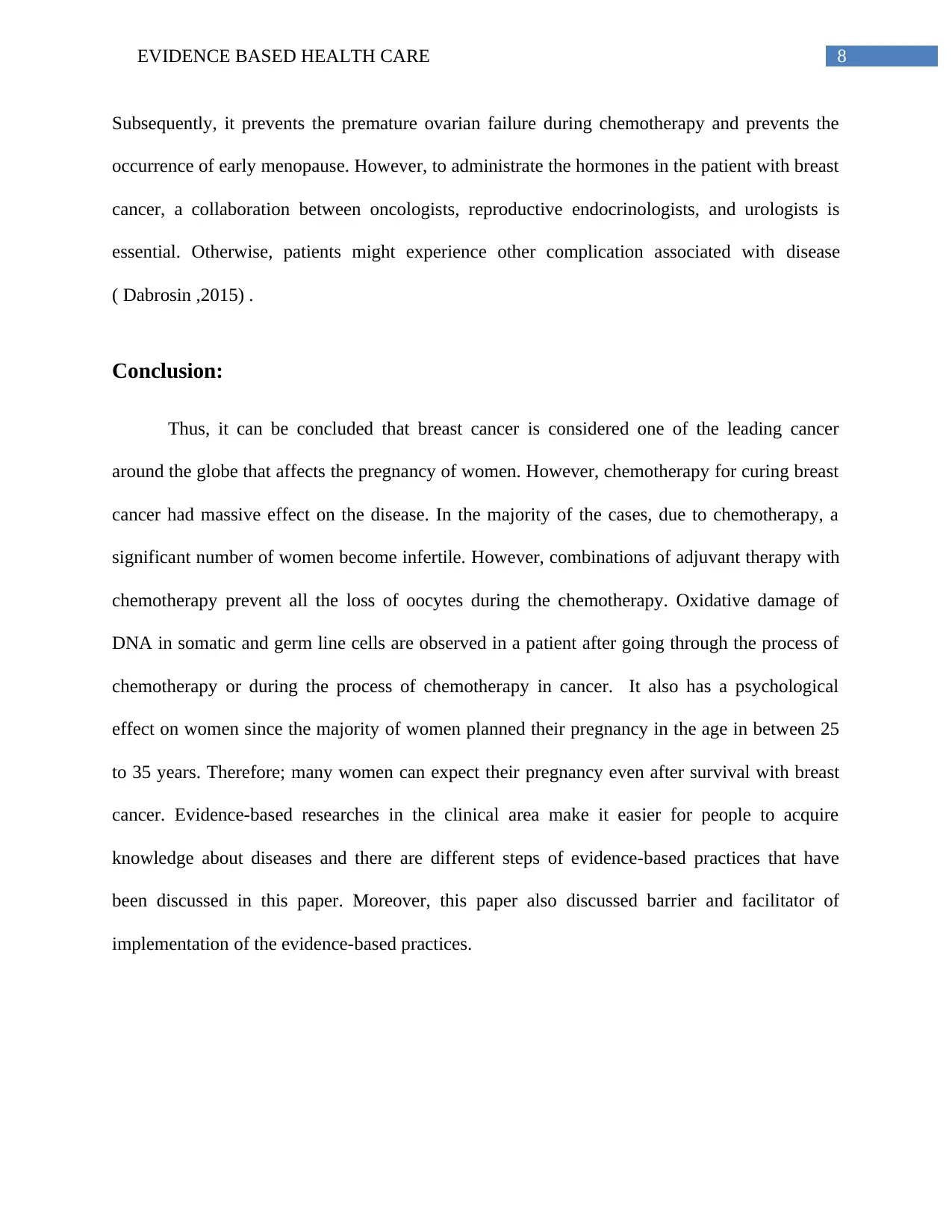
8EVIDENCE BASED HEALTH CARE
Subsequently, it prevents the premature ovarian failure during chemotherapy and prevents the
occurrence of early menopause. However, to administrate the hormones in the patient with breast
cancer, a collaboration between oncologists, reproductive endocrinologists, and urologists is
essential. Otherwise, patients might experience other complication associated with disease
( Dabrosin ,2015) .
Conclusion:
Thus, it can be concluded that breast cancer is considered one of the leading cancer
around the globe that affects the pregnancy of women. However, chemotherapy for curing breast
cancer had massive effect on the disease. In the majority of the cases, due to chemotherapy, a
significant number of women become infertile. However, combinations of adjuvant therapy with
chemotherapy prevent all the loss of oocytes during the chemotherapy. Oxidative damage of
DNA in somatic and germ line cells are observed in a patient after going through the process of
chemotherapy or during the process of chemotherapy in cancer. It also has a psychological
effect on women since the majority of women planned their pregnancy in the age in between 25
to 35 years. Therefore; many women can expect their pregnancy even after survival with breast
cancer. Evidence-based researches in the clinical area make it easier for people to acquire
knowledge about diseases and there are different steps of evidence-based practices that have
been discussed in this paper. Moreover, this paper also discussed barrier and facilitator of
implementation of the evidence-based practices.
Subsequently, it prevents the premature ovarian failure during chemotherapy and prevents the
occurrence of early menopause. However, to administrate the hormones in the patient with breast
cancer, a collaboration between oncologists, reproductive endocrinologists, and urologists is
essential. Otherwise, patients might experience other complication associated with disease
( Dabrosin ,2015) .
Conclusion:
Thus, it can be concluded that breast cancer is considered one of the leading cancer
around the globe that affects the pregnancy of women. However, chemotherapy for curing breast
cancer had massive effect on the disease. In the majority of the cases, due to chemotherapy, a
significant number of women become infertile. However, combinations of adjuvant therapy with
chemotherapy prevent all the loss of oocytes during the chemotherapy. Oxidative damage of
DNA in somatic and germ line cells are observed in a patient after going through the process of
chemotherapy or during the process of chemotherapy in cancer. It also has a psychological
effect on women since the majority of women planned their pregnancy in the age in between 25
to 35 years. Therefore; many women can expect their pregnancy even after survival with breast
cancer. Evidence-based researches in the clinical area make it easier for people to acquire
knowledge about diseases and there are different steps of evidence-based practices that have
been discussed in this paper. Moreover, this paper also discussed barrier and facilitator of
implementation of the evidence-based practices.
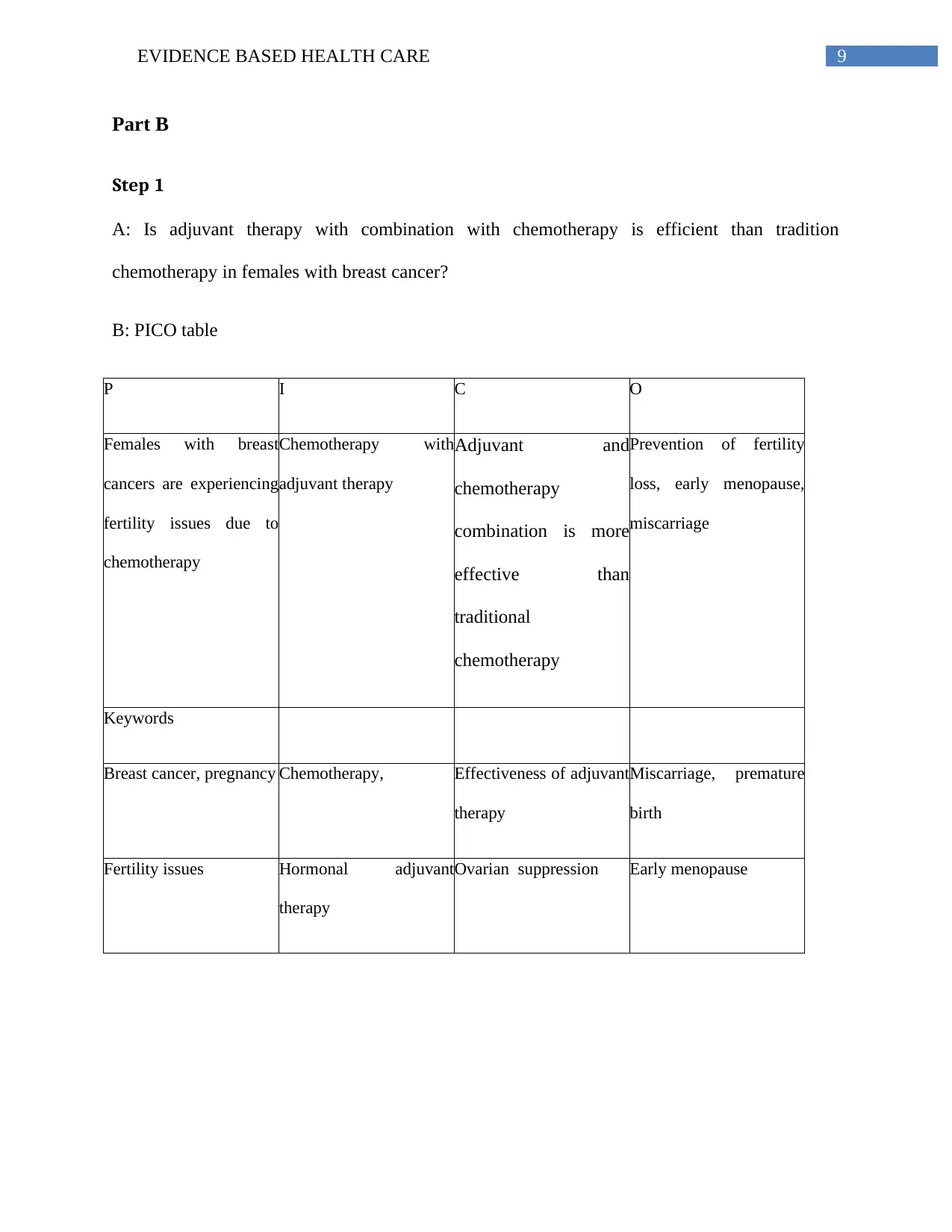
9EVIDENCE BASED HEALTH CARE
Part B
Step 1
A: Is adjuvant therapy with combination with chemotherapy is efficient than tradition
chemotherapy in females with breast cancer?
B: PICO table
P I C O
Females with breast
cancers are experiencing
fertility issues due to
chemotherapy
Chemotherapy with
adjuvant therapy
Adjuvant and
chemotherapy
combination is more
effective than
traditional
chemotherapy
Prevention of fertility
loss, early menopause,
miscarriage
Keywords
Breast cancer, pregnancy Chemotherapy, Effectiveness of adjuvant
therapy
Miscarriage, premature
birth
Fertility issues Hormonal adjuvant
therapy
Ovarian suppression Early menopause
Part B
Step 1
A: Is adjuvant therapy with combination with chemotherapy is efficient than tradition
chemotherapy in females with breast cancer?
B: PICO table
P I C O
Females with breast
cancers are experiencing
fertility issues due to
chemotherapy
Chemotherapy with
adjuvant therapy
Adjuvant and
chemotherapy
combination is more
effective than
traditional
chemotherapy
Prevention of fertility
loss, early menopause,
miscarriage
Keywords
Breast cancer, pregnancy Chemotherapy, Effectiveness of adjuvant
therapy
Miscarriage, premature
birth
Fertility issues Hormonal adjuvant
therapy
Ovarian suppression Early menopause
Secure Best Marks with AI Grader
Need help grading? Try our AI Grader for instant feedback on your assignments.
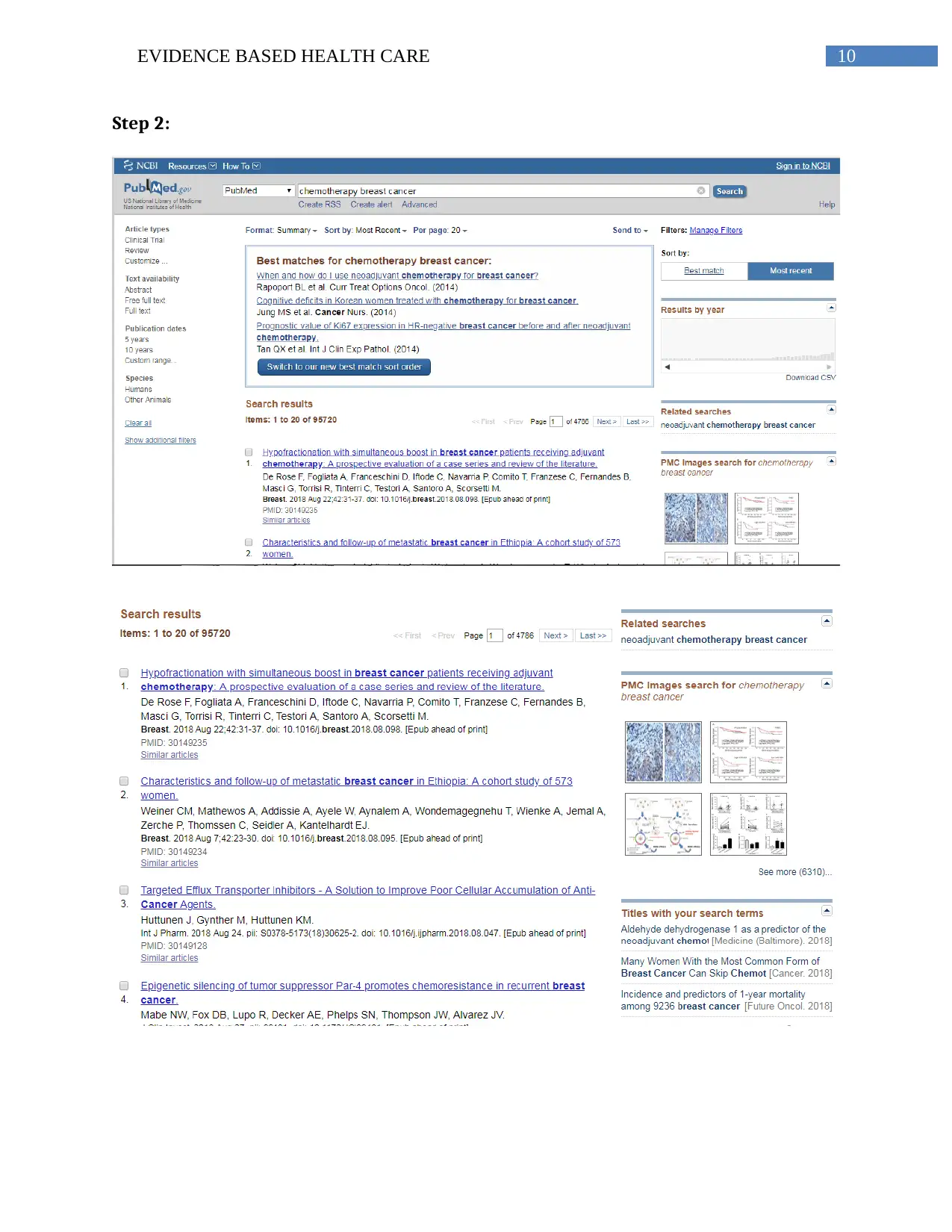
10EVIDENCE BASED HEALTH CARE
Step 2:
Step 2:
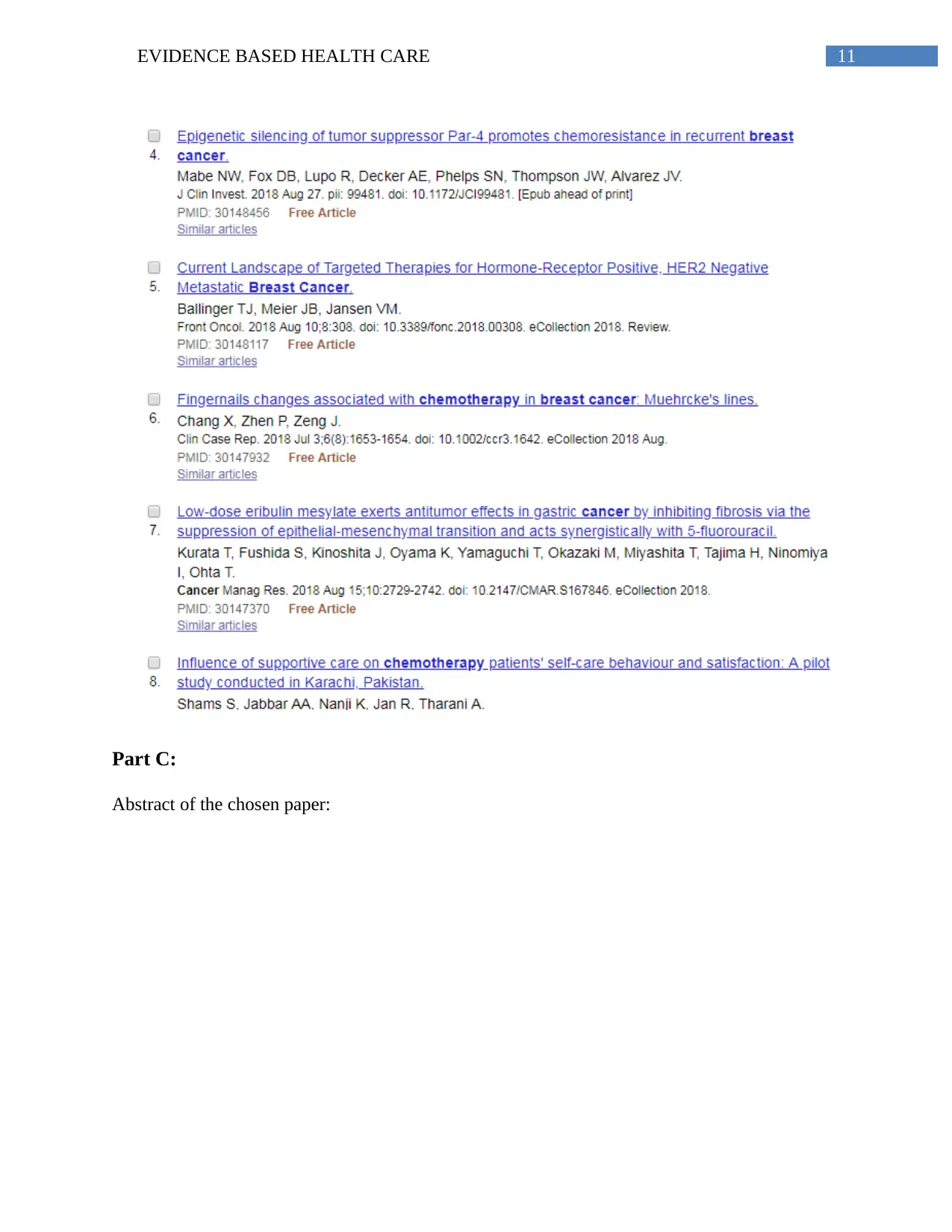
11EVIDENCE BASED HEALTH CARE
Part C:
Abstract of the chosen paper:
Part C:
Abstract of the chosen paper:
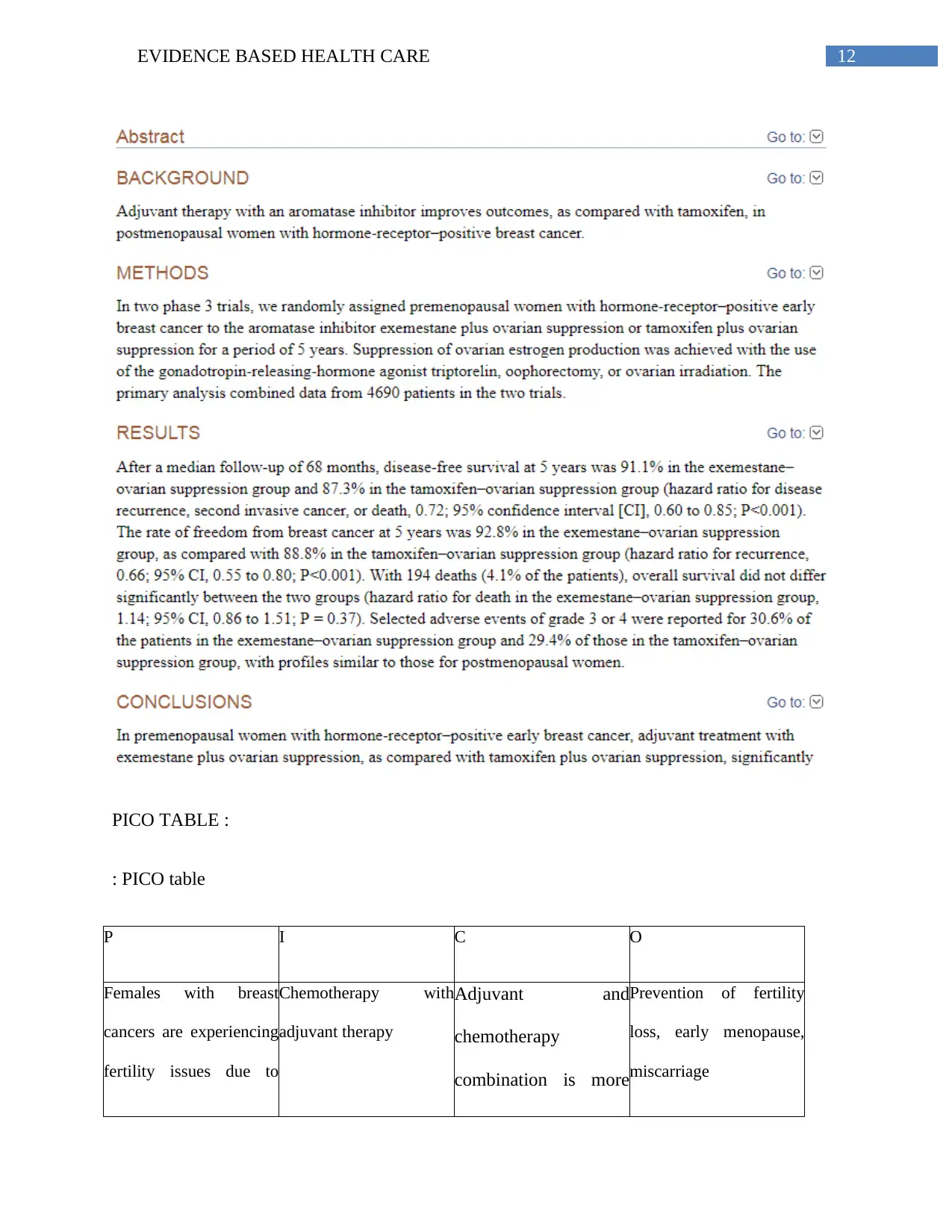
12EVIDENCE BASED HEALTH CARE
PICO TABLE :
: PICO table
P I C O
Females with breast
cancers are experiencing
fertility issues due to
Chemotherapy with
adjuvant therapy
Adjuvant and
chemotherapy
combination is more
Prevention of fertility
loss, early menopause,
miscarriage
PICO TABLE :
: PICO table
P I C O
Females with breast
cancers are experiencing
fertility issues due to
Chemotherapy with
adjuvant therapy
Adjuvant and
chemotherapy
combination is more
Prevention of fertility
loss, early menopause,
miscarriage
Paraphrase This Document
Need a fresh take? Get an instant paraphrase of this document with our AI Paraphraser
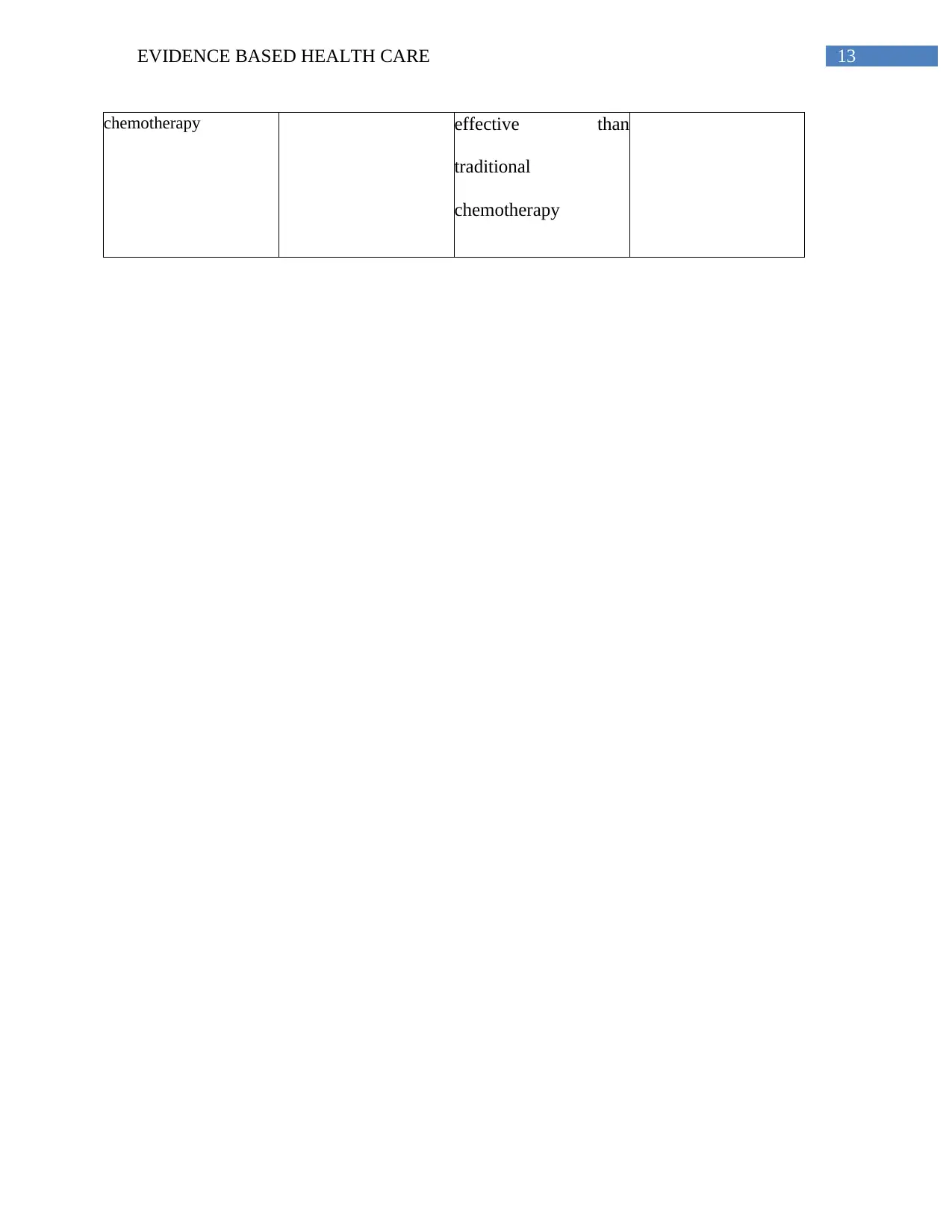
13EVIDENCE BASED HEALTH CARE
chemotherapy effective than
traditional
chemotherapy
chemotherapy effective than
traditional
chemotherapy
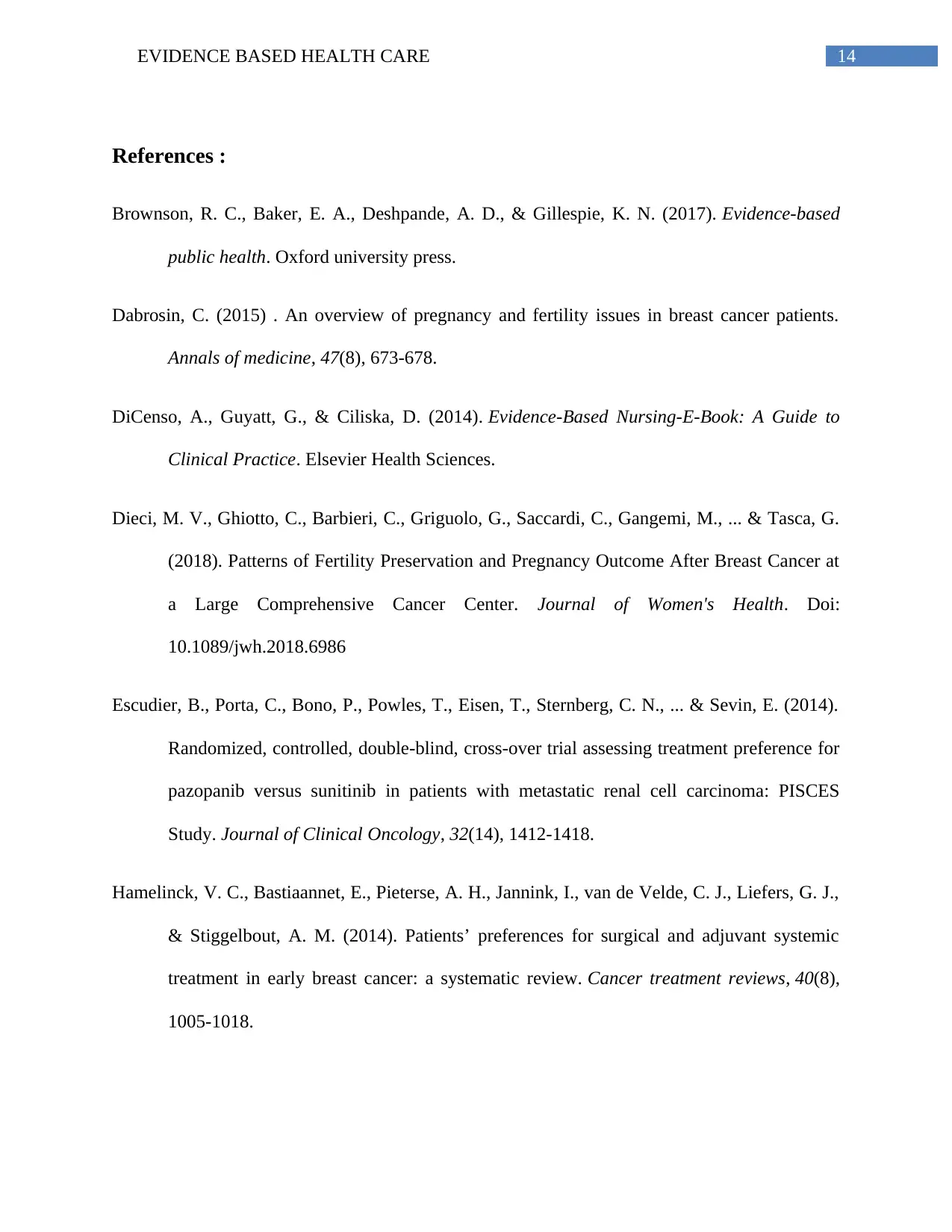
14EVIDENCE BASED HEALTH CARE
References :
Brownson, R. C., Baker, E. A., Deshpande, A. D., & Gillespie, K. N. (2017). Evidence-based
public health. Oxford university press.
Dabrosin, C. (2015) . An overview of pregnancy and fertility issues in breast cancer patients.
Annals of medicine, 47(8), 673-678.
DiCenso, A., Guyatt, G., & Ciliska, D. (2014). Evidence-Based Nursing-E-Book: A Guide to
Clinical Practice. Elsevier Health Sciences.
Dieci, M. V., Ghiotto, C., Barbieri, C., Griguolo, G., Saccardi, C., Gangemi, M., ... & Tasca, G.
(2018). Patterns of Fertility Preservation and Pregnancy Outcome After Breast Cancer at
a Large Comprehensive Cancer Center. Journal of Women's Health. Doi:
10.1089/jwh.2018.6986
Escudier, B., Porta, C., Bono, P., Powles, T., Eisen, T., Sternberg, C. N., ... & Sevin, E. (2014).
Randomized, controlled, double-blind, cross-over trial assessing treatment preference for
pazopanib versus sunitinib in patients with metastatic renal cell carcinoma: PISCES
Study. Journal of Clinical Oncology, 32(14), 1412-1418.
Hamelinck, V. C., Bastiaannet, E., Pieterse, A. H., Jannink, I., van de Velde, C. J., Liefers, G. J.,
& Stiggelbout, A. M. (2014). Patients’ preferences for surgical and adjuvant systemic
treatment in early breast cancer: a systematic review. Cancer treatment reviews, 40(8),
1005-1018.
References :
Brownson, R. C., Baker, E. A., Deshpande, A. D., & Gillespie, K. N. (2017). Evidence-based
public health. Oxford university press.
Dabrosin, C. (2015) . An overview of pregnancy and fertility issues in breast cancer patients.
Annals of medicine, 47(8), 673-678.
DiCenso, A., Guyatt, G., & Ciliska, D. (2014). Evidence-Based Nursing-E-Book: A Guide to
Clinical Practice. Elsevier Health Sciences.
Dieci, M. V., Ghiotto, C., Barbieri, C., Griguolo, G., Saccardi, C., Gangemi, M., ... & Tasca, G.
(2018). Patterns of Fertility Preservation and Pregnancy Outcome After Breast Cancer at
a Large Comprehensive Cancer Center. Journal of Women's Health. Doi:
10.1089/jwh.2018.6986
Escudier, B., Porta, C., Bono, P., Powles, T., Eisen, T., Sternberg, C. N., ... & Sevin, E. (2014).
Randomized, controlled, double-blind, cross-over trial assessing treatment preference for
pazopanib versus sunitinib in patients with metastatic renal cell carcinoma: PISCES
Study. Journal of Clinical Oncology, 32(14), 1412-1418.
Hamelinck, V. C., Bastiaannet, E., Pieterse, A. H., Jannink, I., van de Velde, C. J., Liefers, G. J.,
& Stiggelbout, A. M. (2014). Patients’ preferences for surgical and adjuvant systemic
treatment in early breast cancer: a systematic review. Cancer treatment reviews, 40(8),
1005-1018.
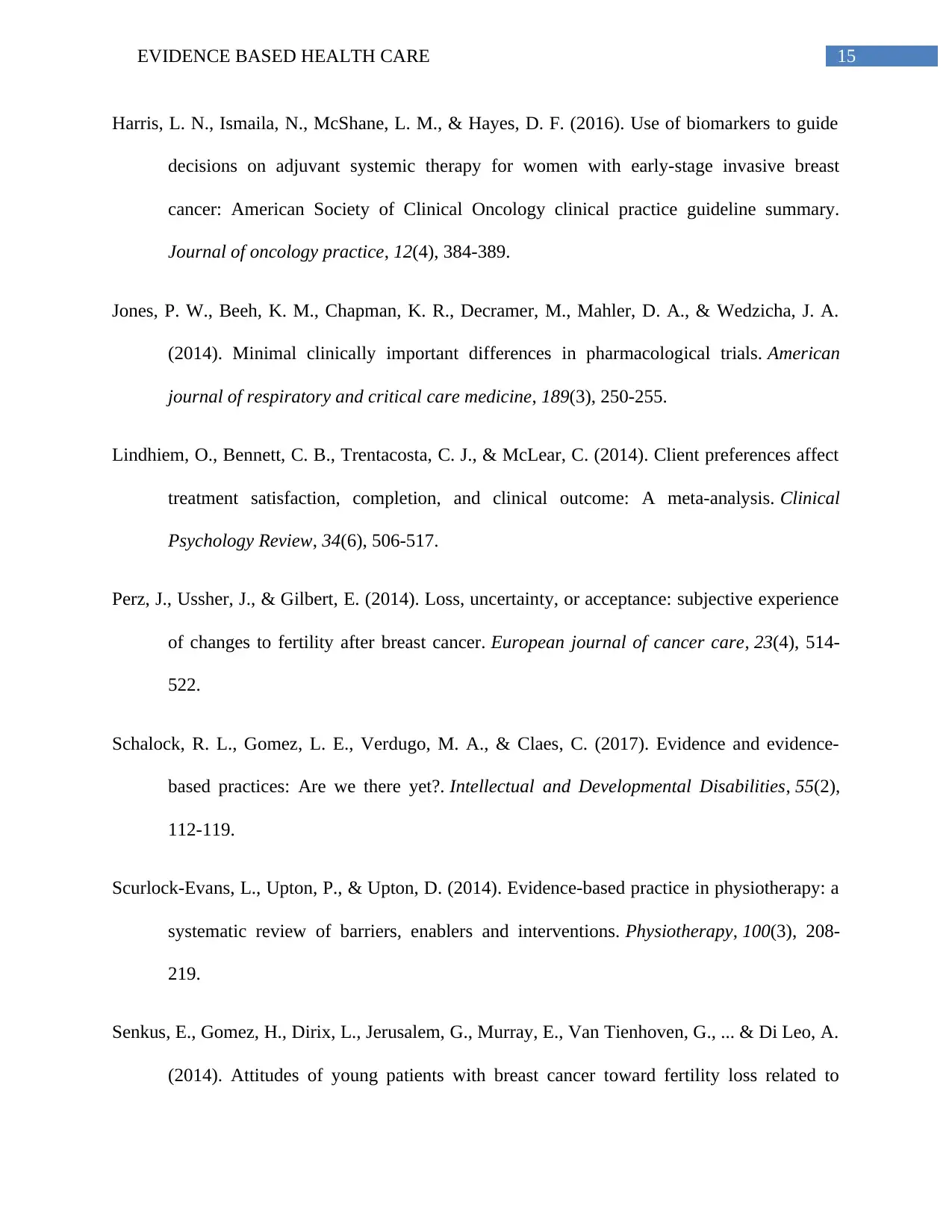
15EVIDENCE BASED HEALTH CARE
Harris, L. N., Ismaila, N., McShane, L. M., & Hayes, D. F. (2016). Use of biomarkers to guide
decisions on adjuvant systemic therapy for women with early-stage invasive breast
cancer: American Society of Clinical Oncology clinical practice guideline summary.
Journal of oncology practice, 12(4), 384-389.
Jones, P. W., Beeh, K. M., Chapman, K. R., Decramer, M., Mahler, D. A., & Wedzicha, J. A.
(2014). Minimal clinically important differences in pharmacological trials. American
journal of respiratory and critical care medicine, 189(3), 250-255.
Lindhiem, O., Bennett, C. B., Trentacosta, C. J., & McLear, C. (2014). Client preferences affect
treatment satisfaction, completion, and clinical outcome: A meta-analysis. Clinical
Psychology Review, 34(6), 506-517.
Perz, J., Ussher, J., & Gilbert, E. (2014). Loss, uncertainty, or acceptance: subjective experience
of changes to fertility after breast cancer. European journal of cancer care, 23(4), 514-
522.
Schalock, R. L., Gomez, L. E., Verdugo, M. A., & Claes, C. (2017). Evidence and evidence-
based practices: Are we there yet?. Intellectual and Developmental Disabilities, 55(2),
112-119.
Scurlock-Evans, L., Upton, P., & Upton, D. (2014). Evidence-based practice in physiotherapy: a
systematic review of barriers, enablers and interventions. Physiotherapy, 100(3), 208-
219.
Senkus, E., Gomez, H., Dirix, L., Jerusalem, G., Murray, E., Van Tienhoven, G., ... & Di Leo, A.
(2014). Attitudes of young patients with breast cancer toward fertility loss related to
Harris, L. N., Ismaila, N., McShane, L. M., & Hayes, D. F. (2016). Use of biomarkers to guide
decisions on adjuvant systemic therapy for women with early-stage invasive breast
cancer: American Society of Clinical Oncology clinical practice guideline summary.
Journal of oncology practice, 12(4), 384-389.
Jones, P. W., Beeh, K. M., Chapman, K. R., Decramer, M., Mahler, D. A., & Wedzicha, J. A.
(2014). Minimal clinically important differences in pharmacological trials. American
journal of respiratory and critical care medicine, 189(3), 250-255.
Lindhiem, O., Bennett, C. B., Trentacosta, C. J., & McLear, C. (2014). Client preferences affect
treatment satisfaction, completion, and clinical outcome: A meta-analysis. Clinical
Psychology Review, 34(6), 506-517.
Perz, J., Ussher, J., & Gilbert, E. (2014). Loss, uncertainty, or acceptance: subjective experience
of changes to fertility after breast cancer. European journal of cancer care, 23(4), 514-
522.
Schalock, R. L., Gomez, L. E., Verdugo, M. A., & Claes, C. (2017). Evidence and evidence-
based practices: Are we there yet?. Intellectual and Developmental Disabilities, 55(2),
112-119.
Scurlock-Evans, L., Upton, P., & Upton, D. (2014). Evidence-based practice in physiotherapy: a
systematic review of barriers, enablers and interventions. Physiotherapy, 100(3), 208-
219.
Senkus, E., Gomez, H., Dirix, L., Jerusalem, G., Murray, E., Van Tienhoven, G., ... & Di Leo, A.
(2014). Attitudes of young patients with breast cancer toward fertility loss related to
Secure Best Marks with AI Grader
Need help grading? Try our AI Grader for instant feedback on your assignments.
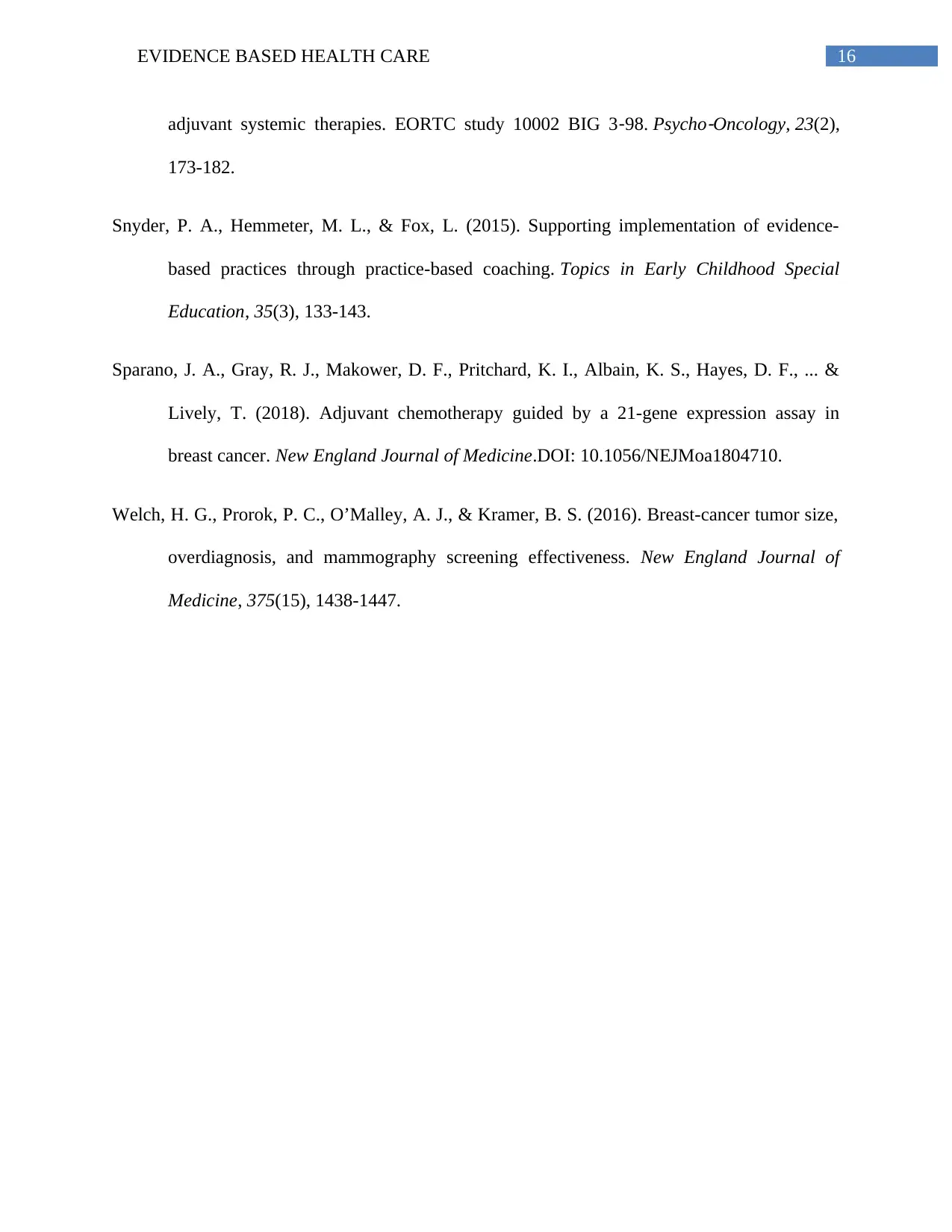
16EVIDENCE BASED HEALTH CARE
adjuvant systemic therapies. EORTC study 10002 BIG 3‐98. Psycho
‐Oncology, 23(2),
173-182.
Snyder, P. A., Hemmeter, M. L., & Fox, L. (2015). Supporting implementation of evidence-
based practices through practice-based coaching. Topics in Early Childhood Special
Education, 35(3), 133-143.
Sparano, J. A., Gray, R. J., Makower, D. F., Pritchard, K. I., Albain, K. S., Hayes, D. F., ... &
Lively, T. (2018). Adjuvant chemotherapy guided by a 21-gene expression assay in
breast cancer. New England Journal of Medicine.DOI: 10.1056/NEJMoa1804710.
Welch, H. G., Prorok, P. C., O’Malley, A. J., & Kramer, B. S. (2016). Breast-cancer tumor size,
overdiagnosis, and mammography screening effectiveness. New England Journal of
Medicine, 375(15), 1438-1447.
adjuvant systemic therapies. EORTC study 10002 BIG 3‐98. Psycho
‐Oncology, 23(2),
173-182.
Snyder, P. A., Hemmeter, M. L., & Fox, L. (2015). Supporting implementation of evidence-
based practices through practice-based coaching. Topics in Early Childhood Special
Education, 35(3), 133-143.
Sparano, J. A., Gray, R. J., Makower, D. F., Pritchard, K. I., Albain, K. S., Hayes, D. F., ... &
Lively, T. (2018). Adjuvant chemotherapy guided by a 21-gene expression assay in
breast cancer. New England Journal of Medicine.DOI: 10.1056/NEJMoa1804710.
Welch, H. G., Prorok, P. C., O’Malley, A. J., & Kramer, B. S. (2016). Breast-cancer tumor size,
overdiagnosis, and mammography screening effectiveness. New England Journal of
Medicine, 375(15), 1438-1447.
1 out of 17
Related Documents
Your All-in-One AI-Powered Toolkit for Academic Success.
+13062052269
info@desklib.com
Available 24*7 on WhatsApp / Email
![[object Object]](/_next/static/media/star-bottom.7253800d.svg)
Unlock your academic potential
© 2024 | Zucol Services PVT LTD | All rights reserved.





